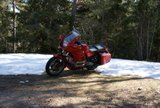1

 Bleed Brakes Mon Nov 24, 2008 9:04 am
Bleed Brakes Mon Nov 24, 2008 9:04 am
yankeeone
Platinum member

Hi , I have a 87 k75 c with drum rear and I changed the fluid in the front .I had a few questions. First , how much free play should there be in the leaver ? also I used a small vacuum pump to pull the fluid through the caliper, and I got a lot of air by the treads on the bleeder, is there a way to seal them ? I think they are the stock type, the rubber cap is held on under them . Any thoughts?
Thanks
Thanks














